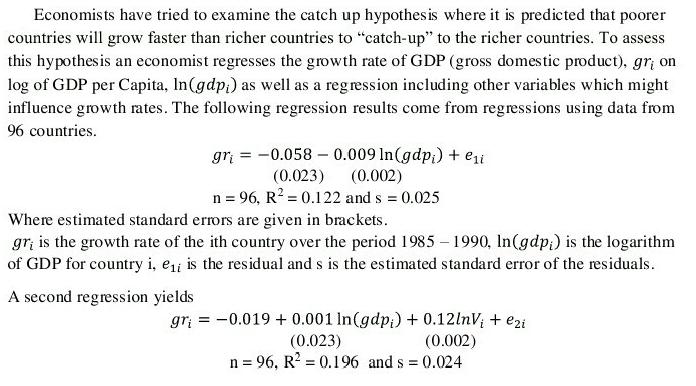Answered step by step
Verified Expert Solution
Question
1 Approved Answer
Economists have tried to examine the catch up hypothes is where it is predicted that poorer countries will grow faster than richer countries to


Economists have tried to examine the catch up hypothes is where it is predicted that poorer countries will grow faster than richer countries to "catch-up" to the richer countries. To assess this hypothes is an economist regresses the growth rate of GDP (gross domestic product), gr on log of GDP per Capita, In(gdp;) as well as a regression including other variables which might influence growth rates. The following regression results come from regressions using data from 96 countries. gri = -0.058 0.009 In(gdp;) + eii (0.023) (0.002) n = 96, R? = 0.122 and s = 0.025 %3D Where estimated standard errors are given in brackets. gr; is the growth rate of the ith country over the period 1985 1990, In(gdp;) is the logarithm of GDP for country i, e1, is the residual and s is the estimated standard error of the residuals. A second regression yields gr; = -0.019 + 0.001 In(gdp;) + 0.12lnV + ezi (0.023) n = 96, R = 0.196 and s = (0.002) 0.024 Where ez is the estimated residual and InV is the ratio of investment to GDP in 1985. a) Test for each regression, the hypothes is that the coefficient on In(gdp;) is zero. What does the result of your tests say about the "catch-up" hypothesis? b) The R? measure is higher for equation (B) than for A. Is this what you would expect? Explain c) The regression results may be affected by heteroskedasticity. Explain what you understand about heteroscedasticity, why the estimation results might be affected by heteroscedasticity and what the effects are if heteroskedasticity is present. d) Interpret the regression results in (A) and (B), identify and explain the R? in each regression.
Step by Step Solution
★★★★★
3.51 Rating (148 Votes )
There are 3 Steps involved in it
Step: 1

Get Instant Access to Expert-Tailored Solutions
See step-by-step solutions with expert insights and AI powered tools for academic success
Step: 2

Step: 3

Ace Your Homework with AI
Get the answers you need in no time with our AI-driven, step-by-step assistance
Get Started


